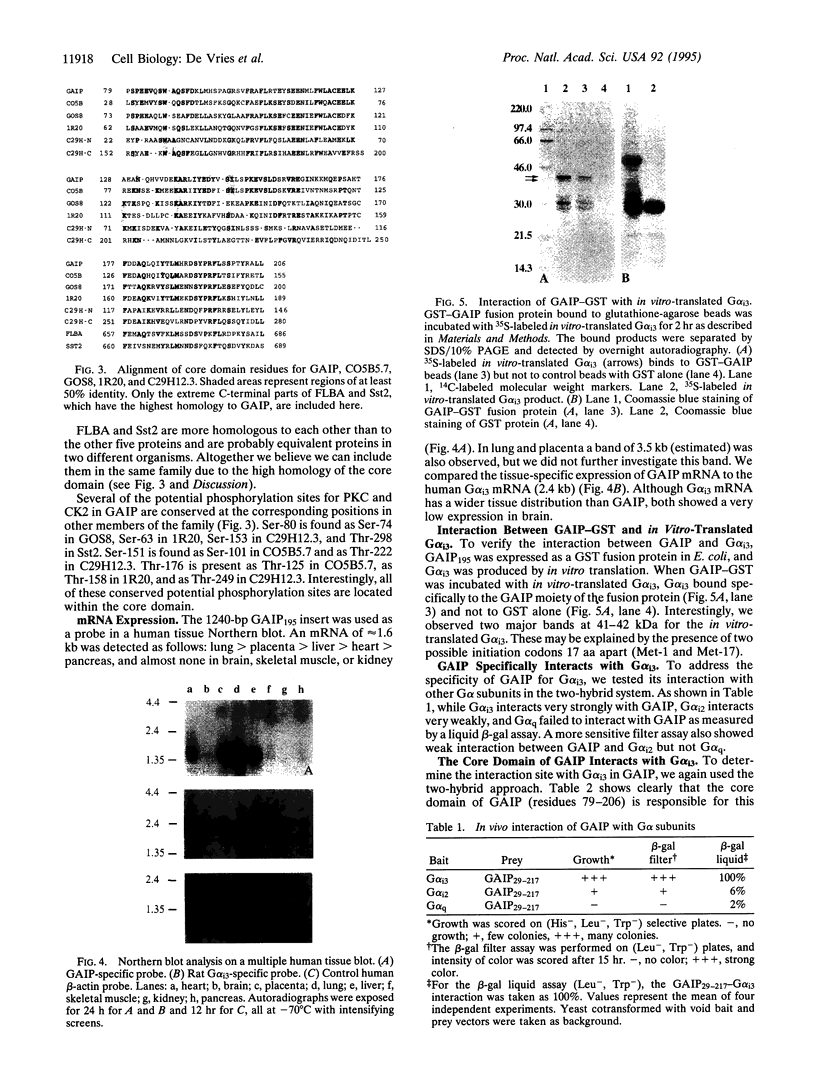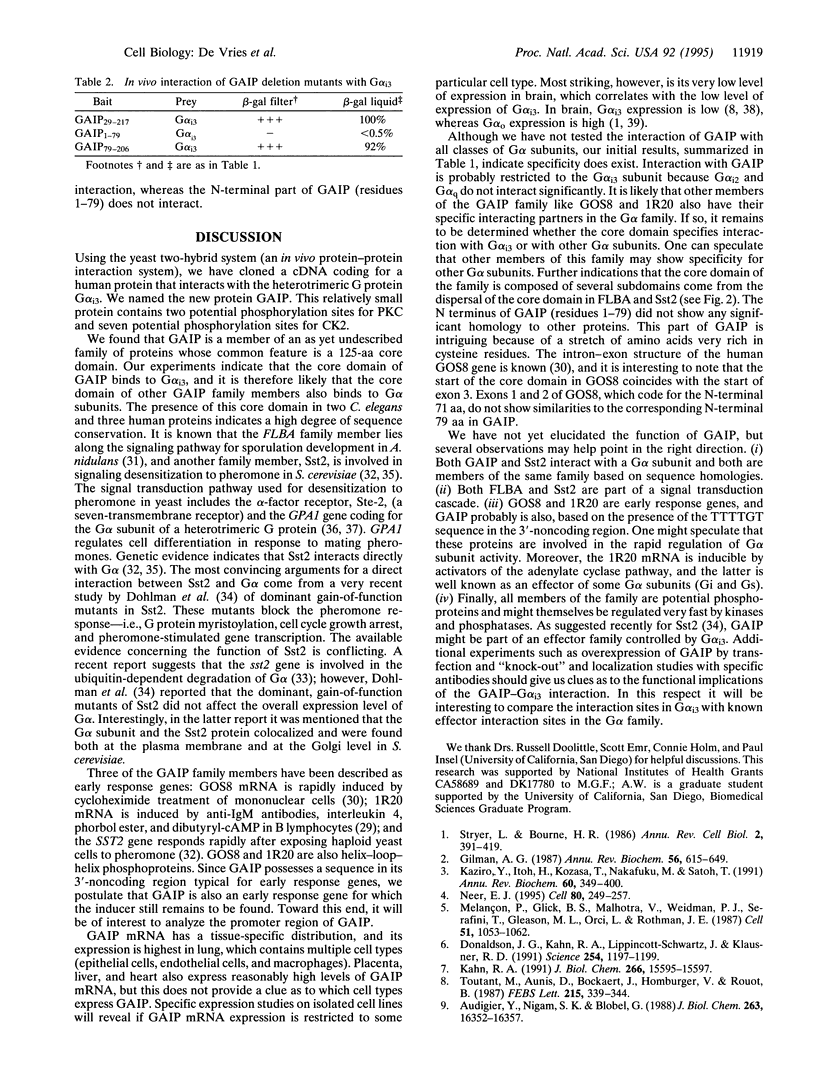Abstract
Using the yeast two-hybrid system we have identified a human protein, GAIP (G Alpha Interacting Protein), that specifically interacts with the heterotrimeric GTP-binding protein G alpha i3. Interaction was verified by specific binding of in vitro-translated G alpha i3 with a GAIP-glutathione S-transferase fusion protein. GAIP is a small protein (217 amino acids, 24 kDa) that contains two potential phosphorylation sites for protein kinase C and seven for casein kinase 2. GAIP shows high homology to two previously identified human proteins, GOS8 and 1R20, two Caenorhabditis elegans proteins, CO5B5.7 and C29H12.3, and the FLBA gene product in Aspergillus nidulans--all of unknown function. Significant homology was also found to the SST2 gene product in Saccharomyces cerevisiae that is known to interact with a yeast G alpha subunit (Gpa1). A highly conserved core domain of 125 amino acids characterizes this family of proteins. Analysis of deletion mutants demonstrated that the core domain is the site of GAIP's interaction with G alpha i3. GAIP is likely to be an early inducible phosphoprotein, as its cDNA contains the TTTTGT sequence characteristic of early response genes in its 3'-untranslated region. By Northern analysis GAIP's 1.6-kb mRNA is most abundant in lung, heart, placenta, and liver and is very low in brain, skeletal muscle, pancreas, and kidney. GAIP appears to interact exclusively with G alpha i3, as it did not interact with G alpha i2 and G alpha q. The fact that GAIP and Sst2 interact with G alpha subunits and share a common domain suggests that other members of the GAIP family also interact with G alpha subunits through the 125-amino-acid core domain.
Full text
PDF




Images in this article
Selected References
These references are in PubMed. This may not be the complete list of references from this article.
- Ali N., Milligan G., Evans W. H. Distribution of G-proteins in rat liver plasma-membrane domains and endocytic pathways. Biochem J. 1989 Aug 1;261(3):905–912. doi: 10.1042/bj2610905. [DOI] [PMC free article] [PubMed] [Google Scholar]
- Altschul S. F., Gish W., Miller W., Myers E. W., Lipman D. J. Basic local alignment search tool. J Mol Biol. 1990 Oct 5;215(3):403–410. doi: 10.1016/S0022-2836(05)80360-2. [DOI] [PubMed] [Google Scholar]
- Asano T., Semba R., Kamiya N., Ogasawara N., Kato K. Go, a GTP-binding protein: immunochemical and immunohistochemical localization in the rat. J Neurochem. 1988 Apr;50(4):1164–1169. doi: 10.1111/j.1471-4159.1988.tb10588.x. [DOI] [PubMed] [Google Scholar]
- Audigier Y., Nigam S. K., Blobel G. Identification of a G protein in rough endoplasmic reticulum of canine pancreas. J Biol Chem. 1988 Nov 5;263(31):16352–16357. [PubMed] [Google Scholar]
- Barr F. A., Leyte A., Mollner S., Pfeuffer T., Tooze S. A., Huttner W. B. Trimeric G-proteins of the trans-Golgi network are involved in the formation of constitutive secretory vesicles and immature secretory granules. FEBS Lett. 1991 Dec 9;294(3):239–243. doi: 10.1016/0014-5793(91)81438-e. [DOI] [PubMed] [Google Scholar]
- Chien C. T., Bartel P. L., Sternglanz R., Fields S. The two-hybrid system: a method to identify and clone genes for proteins that interact with a protein of interest. Proc Natl Acad Sci U S A. 1991 Nov 1;88(21):9578–9582. doi: 10.1073/pnas.88.21.9578. [DOI] [PMC free article] [PubMed] [Google Scholar]
- Colombo M. I., Mayorga L. S., Casey P. J., Stahl P. D. Evidence of a role for heterotrimeric GTP-binding proteins in endosome fusion. Science. 1992 Mar 27;255(5052):1695–1697. doi: 10.1126/science.1348148. [DOI] [PubMed] [Google Scholar]
- Cortés R., Hökfelt T., Schalling M., Goldstein M., Goldsmith P., Spiegel A., Unson C., Walsh J. Antiserum raised against residues 159-168 of the guanine nucleotide-binding protein Gi3-alpha reacts with ependymal cells and some neurons in the rat brain containing cholecystokinin- or cholecystokinin- and tyrosine 3-hydroxylase-like immunoreactivities. Proc Natl Acad Sci U S A. 1988 Dec;85(23):9351–9355. doi: 10.1073/pnas.85.23.9351. [DOI] [PMC free article] [PubMed] [Google Scholar]
- Dietzel C., Kurjan J. Pheromonal regulation and sequence of the Saccharomyces cerevisiae SST2 gene: a model for desensitization to pheromone. Mol Cell Biol. 1987 Dec;7(12):4169–4177. doi: 10.1128/mcb.7.12.4169. [DOI] [PMC free article] [PubMed] [Google Scholar]
- Dietzel C., Kurjan J. The yeast SCG1 gene: a G alpha-like protein implicated in the a- and alpha-factor response pathway. Cell. 1987 Sep 25;50(7):1001–1010. doi: 10.1016/0092-8674(87)90166-8. [DOI] [PubMed] [Google Scholar]
- Dohlman H. G., Apaniesk D., Chen Y., Song J., Nusskern D. Inhibition of G-protein signaling by dominant gain-of-function mutations in Sst2p, a pheromone desensitization factor in Saccharomyces cerevisiae. Mol Cell Biol. 1995 Jul;15(7):3635–3643. doi: 10.1128/mcb.15.7.3635. [DOI] [PMC free article] [PubMed] [Google Scholar]
- Donaldson J. G., Kahn R. A., Lippincott-Schwartz J., Klausner R. D. Binding of ARF and beta-COP to Golgi membranes: possible regulation by a trimeric G protein. Science. 1991 Nov 22;254(5035):1197–1199. doi: 10.1126/science.1957170. [DOI] [PubMed] [Google Scholar]
- Ercolani L., Stow J. L., Boyle J. F., Holtzman E. J., Lin H., Grove J. R., Ausiello D. A. Membrane localization of the pertussis toxin-sensitive G-protein subunits alpha i-2 and alpha i-3 and expression of a metallothionein-alpha i-2 fusion gene in LLC-PK1 cells. Proc Natl Acad Sci U S A. 1990 Jun;87(12):4635–4639. doi: 10.1073/pnas.87.12.4635. [DOI] [PMC free article] [PubMed] [Google Scholar]
- Freter R. R., Irminger J. C., Porter J. A., Jones S. D., Stiles C. D. A novel 7-nucleotide motif located in 3' untranslated sequences of the immediate-early gene set mediates platelet-derived growth factor induction of the JE gene. Mol Cell Biol. 1992 Dec;12(12):5288–5300. doi: 10.1128/mcb.12.12.5288. [DOI] [PMC free article] [PubMed] [Google Scholar]
- Gilman A. G. G proteins: transducers of receptor-generated signals. Annu Rev Biochem. 1987;56:615–649. doi: 10.1146/annurev.bi.56.070187.003151. [DOI] [PubMed] [Google Scholar]
- Guan K. L., Dixon J. E. Eukaryotic proteins expressed in Escherichia coli: an improved thrombin cleavage and purification procedure of fusion proteins with glutathione S-transferase. Anal Biochem. 1991 Feb 1;192(2):262–267. doi: 10.1016/0003-2697(91)90534-z. [DOI] [PubMed] [Google Scholar]
- Guarente L. Yeast promoters and lacZ fusions designed to study expression of cloned genes in yeast. Methods Enzymol. 1983;101:181–191. doi: 10.1016/0076-6879(83)01013-7. [DOI] [PubMed] [Google Scholar]
- Hermouet S., de Mazancourt P., Spiegel A. M., Farquhar M. G., Wilson B. S. High level expression of transfected G protein alpha i3 subunit is required for plasma membrane targeting and adenylyl cyclase inhibition in NIH 3T3 fibroblasts. FEBS Lett. 1992 Nov 9;312(2-3):223–228. doi: 10.1016/0014-5793(92)80940-i. [DOI] [PubMed] [Google Scholar]
- Jones D. T., Reed R. R. Molecular cloning of five GTP-binding protein cDNA species from rat olfactory neuroepithelium. J Biol Chem. 1987 Oct 15;262(29):14241–14249. [PubMed] [Google Scholar]
- Kahn R. A. Fluoride is not an activator of the smaller (20-25 kDa) GTP-binding proteins. J Biol Chem. 1991 Aug 25;266(24):15595–15597. [PubMed] [Google Scholar]
- Kaziro Y., Itoh H., Kozasa T., Nakafuku M., Satoh T. Structure and function of signal-transducing GTP-binding proteins. Annu Rev Biochem. 1991;60:349–400. doi: 10.1146/annurev.bi.60.070191.002025. [DOI] [PubMed] [Google Scholar]
- Lee B. N., Adams T. H. Overexpression of flbA, an early regulator of Aspergillus asexual sporulation, leads to activation of brlA and premature initiation of development. Mol Microbiol. 1994 Oct;14(2):323–334. doi: 10.1111/j.1365-2958.1994.tb01293.x. [DOI] [PubMed] [Google Scholar]
- Leyte A., Barr F. A., Kehlenbach R. H., Huttner W. B. Multiple trimeric G-proteins on the trans-Golgi network exert stimulatory and inhibitory effects on secretory vesicle formation. EMBO J. 1992 Dec;11(13):4795–4804. doi: 10.1002/j.1460-2075.1992.tb05585.x. [DOI] [PMC free article] [PubMed] [Google Scholar]
- Madura K., Varshavsky A. Degradation of G alpha by the N-end rule pathway. Science. 1994 Sep 2;265(5177):1454–1458. doi: 10.1126/science.8073290. [DOI] [PubMed] [Google Scholar]
- Melançon P., Glick B. S., Malhotra V., Weidman P. J., Serafini T., Gleason M. L., Orci L., Rothman J. E. Involvement of GTP-binding "G" proteins in transport through the Golgi stack. Cell. 1987 Dec 24;51(6):1053–1062. doi: 10.1016/0092-8674(87)90591-5. [DOI] [PubMed] [Google Scholar]
- Miyajima I., Nakafuku M., Nakayama N., Brenner C., Miyajima A., Kaibuchi K., Arai K., Kaziro Y., Matsumoto K. GPA1, a haploid-specific essential gene, encodes a yeast homolog of mammalian G protein which may be involved in mating factor signal transduction. Cell. 1987 Sep 25;50(7):1011–1019. doi: 10.1016/0092-8674(87)90167-x. [DOI] [PubMed] [Google Scholar]
- Newton J. S., Deed R. W., Mitchell E. L., Murphy J. J., Norton J. D. A B cell specific immediate early human gene is located on chromosome band 1q31 and encodes an alpha helical basic phosphoprotein. Biochim Biophys Acta. 1993 Nov 16;1216(2):314–316. doi: 10.1016/0167-4781(93)90163-8. [DOI] [PubMed] [Google Scholar]
- Schiestl R. H., Gietz R. D. High efficiency transformation of intact yeast cells using single stranded nucleic acids as a carrier. Curr Genet. 1989 Dec;16(5-6):339–346. doi: 10.1007/BF00340712. [DOI] [PubMed] [Google Scholar]
- Schwaninger R., Plutner H., Bokoch G. M., Balch W. E. Multiple GTP-binding proteins regulate vesicular transport from the ER to Golgi membranes. J Cell Biol. 1992 Dec;119(5):1077–1096. doi: 10.1083/jcb.119.5.1077. [DOI] [PMC free article] [PubMed] [Google Scholar]
- Siderovski D. P., Heximer S. P., Forsdyke D. R. A human gene encoding a putative basic helix-loop-helix phosphoprotein whose mRNA increases rapidly in cycloheximide-treated blood mononuclear cells. DNA Cell Biol. 1994 Feb;13(2):125–147. doi: 10.1089/dna.1994.13.125. [DOI] [PubMed] [Google Scholar]
- Stow J. L., de Almeida J. B., Narula N., Holtzman E. J., Ercolani L., Ausiello D. A. A heterotrimeric G protein, G alpha i-3, on Golgi membranes regulates the secretion of a heparan sulfate proteoglycan in LLC-PK1 epithelial cells. J Cell Biol. 1991 Sep;114(6):1113–1124. doi: 10.1083/jcb.114.6.1113. [DOI] [PMC free article] [PubMed] [Google Scholar]
- Stryer L., Bourne H. R. G proteins: a family of signal transducers. Annu Rev Cell Biol. 1986;2:391–419. doi: 10.1146/annurev.cb.02.110186.002135. [DOI] [PubMed] [Google Scholar]
- Toutant M., Aunis D., Bockaert J., Homburger V., Rouot B. Presence of three pertussis toxin substrates and Go alpha immunoreactivity in both plasma and granule membranes of chromaffin cells. FEBS Lett. 1987 May 11;215(2):339–344. doi: 10.1016/0014-5793(87)80174-6. [DOI] [PubMed] [Google Scholar]
- Weiner J. L., Guttierez-Steil C., Blumer K. J. Disruption of receptor-G protein coupling in yeast promotes the function of an SST2-dependent adaptation pathway. J Biol Chem. 1993 Apr 15;268(11):8070–8077. [PubMed] [Google Scholar]
- Wilson B. S., Komuro M., Farquhar M. G. Cellular variations in heterotrimeric G protein localization and expression in rat pituitary. Endocrinology. 1994 Jan;134(1):233–244. doi: 10.1210/endo.134.1.8275939. [DOI] [PubMed] [Google Scholar]
- Wilson B. S., Palade G. E., Farquhar M. G. Endoplasmic reticulum-through-Golgi transport assay based on O-glycosylation of native glycophorin in permeabilized erythroleukemia cells: role for Gi3. Proc Natl Acad Sci U S A. 1993 Mar 1;90(5):1681–1685. doi: 10.1073/pnas.90.5.1681. [DOI] [PMC free article] [PubMed] [Google Scholar]





